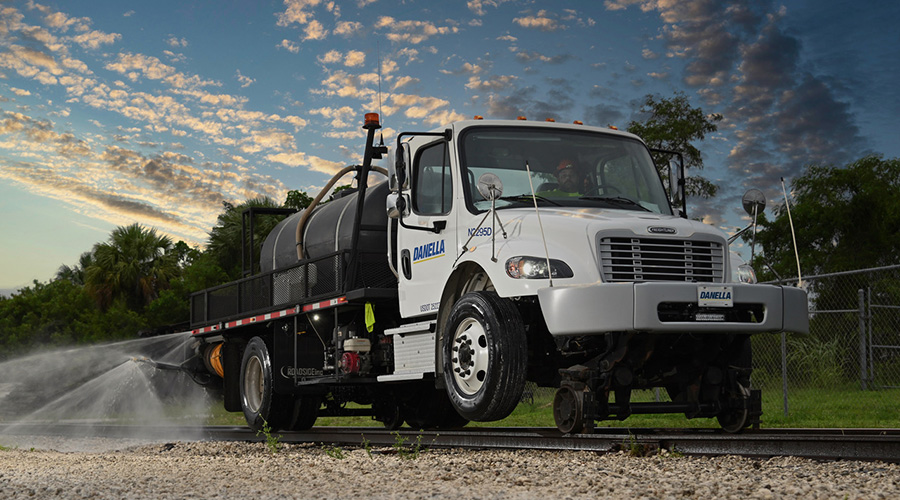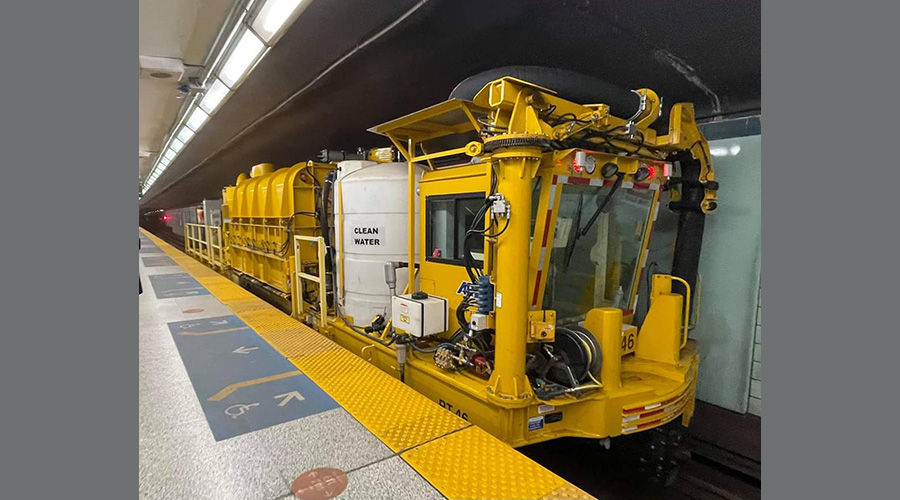Stay updated on news, articles and information for the rail industry
August 2006
Rail News: MOW
When a train derails, many railroads turn to contractors to contain and clean up spills
Whether sulfur is leaking from a punctured tank car or oil is spilling from a locomotive, railroads need to contain potentially hazardous materials to protect the environment.
If a train derails and causes a tank car to leak chemicals, many roads turn to contractors to contain and clean up spills. If locomotives drip oil or diesel in and around shops, a number of railroads call on contractors and suppliers to provide spill containment systems and remediate any contaminated soil.
These days, more roads are seeking contractors’ and suppliers’ expertise to comply with a U.S. Environmental Protection Agency (EPA) regulation. By Oct. 31, 2007, railroads will have to implement a spill prevention, control and countermeasure (SPCC) plan at facilities that handle petroleum and/or non-petroleum oils and could contaminate navigable waters.
Fall 2007 for sure
Part of the Clean Water Act enacted in 2002, the regulation was supposed to take effect shortly afterward. But the EPA extended the rule’s deadline several times to provide time for railroads to prepare and implement an SPCC plan, and the agency to settle litigation brought about by the regulation.
“The EPA has said they would be very surprised if they changed the deadline again,” says Jerry McCombs, vice president of sales and marketing for the Century Group Inc., which supplies railroad spill collection systems. “The regulation is impacting our business quite a bit.”
Witness the increase in railroad orders for the Century Group’s HDPE Enviropan®, a lightweight spill containment system featuring a sloped and ribbed design to maximize material flow and minimize residue. The HDPE pan meets all SPCC standards, including width requirements at 12 feet, and is resistant to a broader array of chemicals than the company’s Concrete and Steel Enviropans®, says McCombs.
The Century Group continues to upgrade and refine the HDPE, and is developing a modified version to meet customer requirements and special trackwork applications, says McCombs.
Portec Rail Products Inc. also is refining its EnviroFORCE™ family of environmental products. The company distributes the products, which include the Catch-All™ Trackmat and GTPlus™ Absorbent track mat, UltraTech's Ultra-TrackPans® and UNIREM's Oil Buster™ Hydrocarbon spill-response product, to the rail industry.
Class Is, regionals, short lines and transit authorities continue to place orders for the Catch-All Trackmat to contain track lubrication greases, but GTPlus mat orders are growing as railroads comply with the SPCC regulation, says John Licsko, Portec Rail's environmental product manager.
GTPlus features enhanced tear resistance, can absorb hydrocarbons more than 12 times its weight and retains strength when removed.
Railroads also continue to purchase Ultra-TrackPans to contain spills at sidings and locomotive facilities. Featuring polyethylene gaskets to prevent spills from falling between rails and pans, Ultra-TrackPans are designed to withstand harsh chemicals and temperatures ranging from -40 F to 140 F.
A natural
Oil Buster is drawing interest, too. A Class I recently completed trials with the product, which is designed to clean up soil contaminated with diesel, oil or hydraulic fluids.
Comprising natural, biodegradable and non-toxic materials, Oil Buster binds with hydrocarbons and stimulates indigenous microorganisms to remediate soil in about four to eight weeks depending on the degree of contamination.
Norfolk Southern Railway is interested in using similar enzyme and bioremediation-agent products to break down and remove residual oil, but a number of states have not approved the use of those compounds, according to an NS safety and environmental department official.
Meanwhile, Trans Environmental Systems Inc. is trying to convince Class Is to use the company’s Open Track Pans™ to contain hazardous materials at transload facilities. The pans feature a lid to prevent rain and snow from causing runoff.“Railroads figure it’s a lot of money to spend for facilities that mostly are in rural locations,” says Trans Environmental Systems founder and President Merle Bishop.
The company also is attempting to pique railroads’ interest in the Haz-Hammock™, a first-response product introduced six years ago that’s designed to temporarily contain materials leaking from a derailed and punctured tank car.
A 15-pound, bathtub-shaped pouch, the Haz-Hammock features ropes or belts that two trained first responders can attach to a leaking car in minutes, says Bishop. Trans Environmental Systems has sold three Haz-Hammocks each to CSX Transportation and the New Jersey Highway Patrol.
“It allows railroads to move a damaged and leaking car one or two miles to a place where they can get to it,” says Bishop.
Call for reinforcements
R.J. Corman Derailment Services L.L.C. also has developed a derailment-response product: a tank-car shield.
Engineered in conjunction with a railroad and fabricated about a year ago, the shield can prevent further car damage, says R.J. Corman Derailment Services President Noel Rush.
A five-foot by five-foot piece of curved steel, the shield is placed against the tank car’s curvature to prevent crimping when a boom lifts a derailed car.
“If we damage a car, it could cost a railroad $20,000 to repair it,” says Rush.
Since 1983, R.J Corman has offered derailment emergency response services, including car and locomotive re-railing, track panel installation and soil remediation. The company’s mobile crews and equipment cover the United States’ eastern two-thirds. Of the 2,400 derailments R.J. Corman responds to each year, about 450 involve tank cars and six involve hazardous materials.
“We want to restore everything after a derailment quickly and safely,” says Rush. “It costs a railroad $25,000 to $250,000 an hour depending on where the derailment occurs.”
Responsive signs
Hulcher Services Inc. also strives to provide fast and efficient derailment emergency-response services, including environmental remediation, chemical transfers from damaged tank cars to a tanker truck, and tank car purging and cleaning. The company has one emergency response office in Canada and nine in the central part of the United States, including the Twin Cities, St. Louis, Atlanta and Houston.
“We believe we have an edge with our response time, quality of crews and equipment, locations and geographic reach,” says Hulcher Services Director of Environmental Technical Services Peter Tilton.
Lately, officials at the company, which also can install track mats and spill containment pans, have noticed railroads are increasing efforts to control and clean up chemical spills.
“Railroads are being more proactive, environmentally,” says Tilton.
The Century Group’s McCombs also believes environmental protection has become a hot topic not only among railroads, but in other industries.
“Companies are trying to show they are a good corporate citizen and sensitive to the environment,” he says.
Keywords
Browse articles on spill containment railroad spill railroad hazmatContact Progressive Railroading editorial staff.


 LRW Honors Amtrak’s Acheson As Railway Woman Of The Year
LRW Honors Amtrak’s Acheson As Railway Woman Of The Year
 From Editor-In-Chief Foran: Of Gender Equity And Inclusion
From Editor-In-Chief Foran: Of Gender Equity And Inclusion
 Spotlight On Some Of Today’s Rail Safety Products
Spotlight On Some Of Today’s Rail Safety Products
 Women of Influence in Rail eBook
Women of Influence in Rail eBook
 railPrime
railPrime







